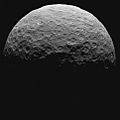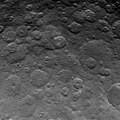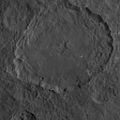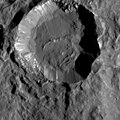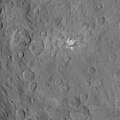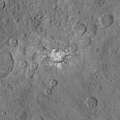Feature Named after Diameter (km) Image Abellio Abellio , Gaul (Celtic ) god of the apple tree [ 12] 32 Achita Achita , a Tiv god of agriculture [ 13] (Close-up Image-1 ) 40 Annona Annona , Roman goddess of crops and of the harvest [ 14] 60 Anura Anura , a Arawak (Guyana ) spirit of the tobacco seeds [ 15] 37 Aristaeus Aristaeus , Greek god of agriculture [ 16] 35.8 Asari Asari , an Assyrian god of agriculture [ 17] (in the image at right, Asari is just above center) 56 Attis Attis , Greek and Phrygian god of vegetation and of fertility [ 18] 22 Axomama Axomamma , an Incan goddess of potatoes [ 19] 5 Azacca Azaka Medeh , Haitian loa of agriculture [ 20] (Close-up Image-1 ; Close-up Image-2 ) 49.91 Begbalel Bagbalel , a Yapese guardian of the taro fields who controls the yield of the crops [ 21] 102 Belun Belun , a Belarusian god of the fields [ 22] 36.04 Besua Besuā , a minor Egyptian grain god [ 23] 17 Bilwis Bilwis , a German corn spirit [ 24] 7 Binayo Binayo , a Mangyan female spirit, caretaker of rice spirits [ 25] 16 Bonsu Bonsu , a Batek god who watches over the fruits and flowers [ 26] 31 Braciaca Celtic mythology god of malt [ 27] 8 Cacaguat Nicaraguan god of cacao [ 28] 13.6 Centeotl Centeotl , Aztec god of maize and agriculture [ 29] 6 Chaminuka Shona (Zimbabwe ) spirit who provides rains in times of droughts [ 30] (Close-up Image ) 122 Coniraya Coniraya , Inca lunar deity responsible for agricultural terracing and irrigation [ 31] 135 Consus Consus , ancient Roman agricultural god who watched over the harvested and stored crop. [ 32] 64 Cozobi Cozobi , Zapotec (south Mexico ) god of maize and of abundant food [ 33] 24 Dada Nigerian god of vegetables [ 34] 12 Damia Greek goddess of the cornfields and crops [ 35] 7 Dantu Dantu, Ga god associated with the planting of grain [ 36] (Close-up Image-1 ; Close-up Image-2 ; Close-up Image-3 ; Close-up Image-4 ) 126 Darzamat Dārza māte ; Latvian deity, 'mother of the garden' [ 37] 92 Datan Polish god of the tilling of the soil [ 38] (Close-up Image-1 ; Close-up Image-2 ; Close-up Image-3 ; Close-up Image-4 ; Close-up Image-5 ) 60 Dikhan Dikhan baba; Kazakh pre-Islamic deity of farming [ 39] 21 Doliku Dahomeyan (Benin ) god of the fields [ 40] 15 Duginavi Kogi (northern Colombia ) god who taught people agriculture [ 41] 155 Emesh Sumerian god of vegetation and agriculture [ 42] 20 Enkimdu Sumerian god of farming [ 43] 9 Ernutet Ernutet , Egyptian cobra-headed goddess of the harvest [ 44] (Close-up Image-1 ; Close-up Image-2 ; Close-up Image-3 / organics detected [ 45] ) 53.4 Ezinu Sumerian goddess of grain [ 46] (Close-up Image-1 ; Close-up Image-2 ; Close-up Image-3 ; Close-up Image-4 ; Close-up Image-5 ) 116 Fejokoo Aboh (Igbo ) deity who provided the yam [ 47] (in the image at right, Fejokoo is just right of center) (Close-up Image ) 68 Fluusa Oscan (ancient southern Italy ) goddess of flowers, counterpart of the Roman goddess Flora . 60 Gaue Germanic goddess to whom offerings are made for the rye harvest [ 48] (Close-up Image-1 ; Close-up Image-2 ; Close-up Image-3 ) 80 Geshtin Sumerian goddess of the grapevine and wine [ 49] (Close-up Image ) 80 Ghanan Chanan, Tzeltal god of maize [ 50] (Close-up Image-1 ; Close-up Image-2 ; Close-up Image-3 ) 68 Hakumyi Paraguayan , Brazilian and Bolivian spirit helpful in gardening [ 51] 29.2 Hamori Japanese god, protector of tree leaves [ 52] (Close-up Image ) 60 Hatipowa Indian god of agriculture [ 53] 40 Haulani Hau-lani, Hawaiian plant goddess [ 54] (Context Image ) 34 Heneb Early Egyptian god of grain, produce and vineyards [ 55] 39 Homshuk Sierra Popoluca (south Mexico ) spirit of corn (maize) [ 56] 70 Ialonus Ialonus , Celtic (British ) god of the cultivated field and of the meadows [ 57] 16.5 Ikapati Lakapati or Ikapati, Tagalog goddess of the cultivated lands [ 58] (Close-up Image-1 ; Close-up Image-2 ; Close-up Image-3 ; Close-up Image-4 ; Close-up Image-5 ) 50 Inamahari One of a pair (male and female) of Siouan (South Carolina , perhaps Catawba ) deities invoked for success at the sowing season [ 59] 68 Inkosazana Inkosazana, the Zulu agricultural goddess [ 60] 40 Insitor Insitor , helper god of Ceres and Roman agricultural deity in charge of the sowing [ 61] 26 Jacheongbi Jacheongbi , Korean goddess of agriculture in Jeju who is said to have brought 5 grains to the island. [ 62] 31 Jaja Abkhaz harvest goddess [ 63] 22 Jarimba Yarimba, Antakirinya (Australia ) god of flowers and fruit [ 64] 69 Jarovit Jarovit (Yarovit), proto-Slavic god of fertility and harvest, who comes down to the Underworld after each harvest and returns each spring [ 65] (Close-up Image-1 ; Closeup Image-2 ) 66 Juling Orang Asli (formerly also called Sakai people, now a term for separate and distinct group) / (Malaysia ) spirit of the crops [ 66] (Close-up Image ) 20 Jumis Jumis , Latvian god of fertility of the field. [ 67] 15 Kahukura Kahukura , Maori god of kumara (sweet potato) crops. [ 68] 6.3 Kaikara Konjo and Banyoro (Uganda ) goddess of harvest [ 69] 72 Kait Hattic goddess of grain (Asia Minor). Defines zero degrees longitude on Ceres [ 70] 0.4 Kaneki Micronesian (Pohnpei/Ponape Island, Caroline Islands) god of the coconut palm [ 71] 31.5 Kerwan Hopi spirit of the sprouting maize [ 72] (Close-up Image ) 280 Kiriamma Veddan (Sri Lanka ) goddess and provider of food ('milk mother') [ 73] 18.7 Kirnis Kirnis , Lithuanian spirit and guardian of cherry trees [ 74] (in the image at right, Kirnis is near the terminator at 4 o'clock from the bright spots) (Close-up Image-1 ; Close-up Image-2 ) 115 Kokopelli Pueblo fertility deity who presides over agriculture [ 75] 34 Kondos Finnish agricultural deity [ 76] 44 Kumitoga [ kumiˈtoŋa] Kumitoga (Kumitonga), Tuamotuan goddess of feasting mats and one of three goddesses of plant life [ 77] 96 Kupalo Russian (Slavic ) god of vegetation and of the harvest [ 78] (Close-up Image-1 ; Close-up Image-2 ; Close-up Image-3 ) 26 Laukumate Latvian spirit, 'mother of the fields' [ 79] 29.7 Liber Liber , Roman god of agriculture [ 80] (Close-up Image ) 23 Lociyo Zapotec (Mexico ) deity to whom a ceremony is performed when the first chilli plant is cut [ 81] 37.8 Lono Lono , Hawaiian god of agriculture [ 82] (Close-up Image ) 20 Meanderi Ngaing (New Guinea ) goddess of taro, sugar cane and other foods [ 83] (Close-up Image ) 103 Megwomets Yurok (California ) dwarf god of acorns and distributor of vegetal abundance [ 84] 78.7 Messor Messor , helper god of Ceres and Roman god of harvesting, of cutting of the grain [ 85] (Close-up Image-1 ; Close-up Image-2 ; Close-up Image-3 ) 40 Mlezi Name of god Tilo as "Food-Giver" (Tonga tribes of Malawi and Zambia) [ 86] 41.5 Mondamin Ojibwe corn (maize) god (Lake Superior area, Canada and the United States ) [ 87] (Close-up Image-1 ; Close-up Image-2 ; Close-up Image-3 ; Close-up Image-4 ; Close-up Image-5 ) 126 Nawish Acoma guardian of the field [ 88] 77 Nepen Egyptian god of rain [ 89] 26.4 Ninsar Ninsar , Sumerian goddess of plants and vegetation [ 90] 40 Nunghui Canelos Quichua (Ecuador) female spirit of garden soil and pottery clay [ 91] 22 Occator Occator , helper god of Ceres and Roman agricultural deity of the harrowing. [ 92] "Region A" in ground-based images (Close-up Image-1 ; Close-up Image-2 ; Close-up Image-3 ; Close-up Image-4 ; Close-up Image-5 ; Close-up Image-6 ; Close-up Image-7 ; Close-up Image-8 ; Close-up Image-9 ; Close-up Image-10 ; Close-up Image-11 ; Close-up Image-12 ) 92 Oltagon Philippine agricultural goddess [ 93] 28 Omonga Mori (Tomori) rice spirit that dwells in the Moon [ 94] (Close-up Image ) 77 Oxo Candomblé (and Yoruba ) god of agriculture [ 95] (Context Image ; Close-up Image - "Water-Ice" Detected ; Close-up Image ) 10 Peko Seto (southeast Estonia) fertility god [ 96] 11 Piuku Carib (Barama River , Guyana ) god of the manioc [ 97] 31 Rao Mangarevan god involved in the planting of turmeric [ 98] (Close-up Image ) 12 Ratumaibulu Fijian serpent god of agriculture and the underworld [ 99] 20 Razeka Arabian tribal god worshipped as the provider of food [ 100] 38.38 Rongo Rongo , Maori god of cultivation [ 101] (Close-up Image ) 68 Roskva Teutonic goddess who symbolises the ripe fields of harvest [ 102] 22 Sekhet Egyptian name of Isis as goddess of cultivated lands and fields [ 103] (Close-up Image ) 41 Shakaema Shakaëma, Jivaro (Ecuador and Peru ) god of vegetation invoked in the planting and cultivation of bananas [ 104] 49 Shennong Shennong , Chinese buffalo-headed deity of agriculture [ 105] 32.5 Sintana Kogi deity who produced fertile black earth [ 106] (Close-up Image-1 ; Close-up Image-2 ; Close-up Image-3 ) 61 Tafakula Tongan (Polynesia ) goddess invoked for favourable seasons for the crops [ 107] 34 Tahu Maori (New Zealand ) personification of all food [ 108] 25 Takel Yak Takel, Semang goddess of the tuber harvest [ 109] (Close-up Image ) 21 Tawals Polish god of the fields and of the tilling [ 110] 8.8 Telepinu Telepinu Hittite god of fertility and vegetation [ 111] 31 Thrud Scandinavian goddess who "signifies the seed" [ 112] 7.8 Tibong Land Dayak (Borneo ) malevolent spirit who devours and depletes the rice [ 113] 37 Toharu Pawnee god of food and vegetation [ 114] (Close-up Image ) 87 Tupo An obscure Mangarevan god of disorder (perhaps the same as Tu or Tupa), involved in turmeric planting [ 115] (Close-up Image-1 ; Close-up Image-2 ) 37 Urvara Ancient titular deity of plants (Iranian) and fertile fields (Indian) [ 116] (Close-up Image-1 ; Close-up Image-2 ; Close-up Image-3 ; Close-up Image-4 ; Close-up Image-5 ) 163 Victa Roman goddess of food and nourishment [ 117] 30 Vinotonus Britonic (Celtic) god of the vine (wine) [ 118] 140 Xevioso Fon (Benin/Dahomey) god of thunder and fertility [ 119] 8.5 Xochipilli Xochipilli , Aztec fertility god associated with maize and flowers; patron of music and dance [ 120] 22.7 Yalode Dahomeyan goddess worshipped by women at harvest rites [ 121] (Close-up Image-1 ; Close-up Image-2 ; Close-up Image-3 ; Close-up Image-4 ; Close-up Image-5 ; Close-up Image-6 ; Close-up Image-7 ) 260 Zadeni Zadeni , ancient Georgian god of bountiful harvests [ 122] (Close-up Image-1 ; Close-up Image-2 ; Close-up Image-3 ) 129.28 Zatik Armenian god of fertility and vegetation [ 123] 4 








